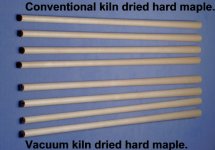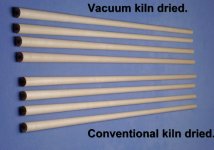Craig, you probably know that shaftwood with more than 30 GPI is extremely, extremely rare today. In the over 2000 pieces I've purchased in the last year, rarely do the ring counts get into the high 20's, low 30's. A lot of the time I only pay attention to GPI in passing. The majority of shaft blanks fall in the 10-15 GPI range with a scattered and thinning distribution above and below that range.
My point is that I've found no relationship between high ring count and superior playing characteristics. In other words, the high ring count blanks are just as likely to be various degrees of great, good or poor as lower ring count blanks. A 5-6 GPI shaft blank is also uncommon. It would have about 3 growth rings near the ferrule. This might be distracting if the grain lines were real prounounced.
Because of what has become common misinformation, and their scarcity, high GPI shafts often command a premium price. I like them from that standpoint. However, the high GPI shaft does not automatically equal superior playing shaft. I'm glad to hear that you have had great success with cutoffs from antique cues, Craig. I'm flat out jealous that you so easily acquire them in your area

The fine craftsmanship in many of the old Brunswick cues is simply amazing. I especially love the old veneered cues. I appreciate your contributions to the forum. Please do not read disrespect into my comments. The learning with cue woods and constructing cues is never ending--that's a good part of the fun of it. I am grateful to the cuemakers and woodsmen who've freely shared their knowledge.
Martin

